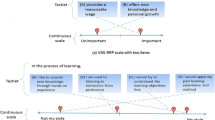Abstract
In this work, we empirically compare the rankings produced by several multi-criteria decision-making methods. We analyzed multi-MOORA, TOPSIS and three different settings for VIKOR. Using decision matrices with different number of alternatives and criteria, we compared the rankings produced using the Spearman’s correlation coefficient index. Our results showed that VIKOR could fail to obtain a ranking due to the failure of certain calculations. The rankings produced by TOPSIS and multi-MOORA were very similar, while the rankings produced by the different VIKOR variants showed a great variability.





Similar content being viewed by others
References
Abu Taha, R., Daim, T.: Multi-criteria applications in renewable energy analysis, a literature review. In: Daim, T., Oliver, T., Kim, J. (eds.) Research and Technology Management in the Electricity Industry: Methods, Tools and Case Studies, pp. 17–30. Springer, London (2013)
Baležentis, T., Baležentis, A.: A survey on development and applications of the multi-criteria decision making method MULTIMOORA. J. Multi-Criteria Decis. Anal. 21(3–4), 209–222 (2014)
Brans, J.P., Mareschal, B., Vincke, P.: Promethee: a new family of outranking methods in multicriteria analysis. In: Operational Research ’84, Proceedings of the Tenth International Conference, pp. 477–490. Washington, DC (1984)
Brans, J.P., Vincke, Ph, Mareschal, B.: How to select and how to rank projects: the Promethee method. Eur. J. Oper. Res. 24(2), 228–238 (1986)
Brauers, W.K.M., Zavadskas, E.K.: Project management by multimoora as an instrument for transition economies. Technol. Econ. Dev. Econ. 16(1), 5–24 (2010)
Brauers, Willem Karel M., Zavadskas, Edmundas Kazimieras: Robustness of multimoora: a method for multi-objective optimization. Informatica 23(1), 1–25 (2012)
Chen, S.J., Hwang, C.L., Hwang, F.P.: Fuzzy multiple attribute decision making(methods and applications). Lecture Notes in Economics and Mathematical Systems (1992)
Mardani, A., Jusoh, A., Zavadskas, E.K.: Fuzzy multiple criteria decision-making techniques and applications: two decades review from 1994 to 2014. Expert Syst. Appl. 42(8), 4126–4148 (2015)
Mardani, A., Jusoh, A., Zavadskas, E.K., Khalifah, Z., Nor, K.M.D.: Application of multiple-criteria decision-making techniques and approaches to evaluating of service quality: a systematic review of the literature. J. Bus. Econ. Manage. 16(5), 1034–1068 (2015)
Mohamed, N.H., Lamsali, H., Sathyamoorthy, D.: Multi-criteria decision making (mcdm) for technical evaluation of tenderers: a review of methods employed. Defence S T Tech Bull 8(1), 90–102 (2015)
Opricovic, S.: Multicriteria Optimization of Civil Engineering Systems. Faculty of Civil Engineering, Belgrade (1998)
Opricovic, S., Tzeng, G.-H.: Compromise solution by MCDM methods: a comparative analysis of VIKOR and TOPSIS. Eur. J. Oper. Res. 156(2), 445–455 (2004)
Roy, B., Hugonnard, J.C.: Ranking of suburban line extension projects on the Paris metro system by a multicriteria method. Transp. Res. A: Gen. 16(4), 301–312 (1982)
Saaty, T.L.: The Analytic Hierarchy Process. McGraw-Hill, New York (1980)
Triantaphyllou, E.: Multi-criteria decision making methods. In: Multi-criteria Decision Making Methods: A Comparative Study, pp. 5–21. Springer, New York (2000)
Triantaphyllou, E., Chi-Tun, L.: Development and evaluation of five fuzzy multiattribute decision-making methods. Int. J. Approximate Reasoning 14(4), 281–310 (1996)
Triantaphyllou, E., Mann, S.H.: An examination of the effectiveness of multi-dimensional decision-making methods: a decision-making paradox. Decis. Support Syst. 5(3), 303–312 (1989)
Yildiz, A., Yayla, A.Y.: Multi-criteria decision-making methods for supplier selection: a literature review. S. Afr. J. Ind. Eng 26(2), 158–177 (2015)
Zanakis, S.H., Solomon, A., Wishart, N., Dublish, S.: Multi-attribute decision making: a simulation comparison of select methods. Eur. J. Oper. Res. 107(3), 507–529 (1998)
Acknowledgments
Authors acknowledge support through projects TIN2014-55024-P and P11-TIC-8001 from the Spanish Ministry of Economy and Competitiveness, and Consejería de Economía, Innovación y Ciencia, Junta de Andalucía (both including FEDER funds), respectively. B. Ceballos enjoys a training Grant research staff under project TIN2011-27696-C02-01 (Spanish Ministry of Economy and Competitiveness).
Author information
Authors and Affiliations
Corresponding author
Rights and permissions
About this article
Cite this article
Ceballos, B., Lamata, M.T. & Pelta, D.A. A comparative analysis of multi-criteria decision-making methods. Prog Artif Intell 5, 315–322 (2016). https://doi.org/10.1007/s13748-016-0093-1
Received:
Accepted:
Published:
Issue Date:
DOI: https://doi.org/10.1007/s13748-016-0093-1




